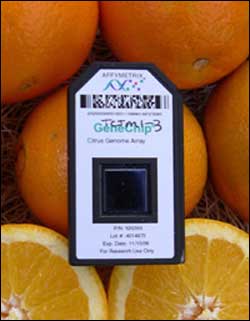UCR researchers design chip that can improve citrus varieties

The GeneChip® Citrus Genome Array can improve citrus varieties and suggest ways to better manage them.
GeneChip Citrus Genome Array launched by Affymetrix, Inc.
UC Riverside researchers, in partnership with Affymetrix, Inc., have designed a chip – the GeneChip® Citrus Genome Array – that can improve citrus varieties and suggest ways to better manage them. By helping determine which genes are turned on in a tissue of citrus – genes that are associated with taste, acidic content and disease, for example – the chip provides information useful to researchers for rectifying existing problems and making improvements to the fruit.
The citrus array will be used to develop new diagnostic tools for the improvement of citrus agriculture and post-harvest fruit handling, as well as to understand mechanisms underlying citrus diseases. Researchers will study traits pertinent to the citrus industry such as easy peeling, seedlessness, flavor components, pest and disease control, nutritional characteristics, and reproductive development.
“The citrus array helps us quickly examine a certain trait in citrus,” said Mikeal Roose, a professor of genetics in the Department of Botany and Plant Sciences at UCR and a leader of the three-year research project. “For a trait posing a problem for the consumer, such as an undesirable flavor, we can identify genes associated with the trait and target these for correction to improve the flavor. The chip also helps us address citrus diseases by helping us see what happens in cells when a citrus plant is under attack from a virus. And with this chip we can better understand what happens at the cellular level when oranges are put in cold storage after they are harvested, leading eventually to better methods of storage that improve fruit flavor.”
Manufactured by Affymetrix, Inc., the GeneChip® Citrus Genome Array is made up of a glass wafer on to which nearly one million different pieces of citrus DNA are deposited on a grid or microarray using methods similar to those used to produce computer chips. The glass wafer is encased in a plastic container somewhat smaller than the size of a credit card.
To use the chip, researchers purify total RNA (which reflects the genes expressed in the tissue) from plant tissue, make a copy of these molecules with a chemical tag added, and then “wash” the chip with the RNA sample. If a gene is being expressed in the tissue, its corresponding RNA will be present and bind to the complementary DNA sequences on the chip. The locations of the bound RNA have a visible signal because of the tag, rather like bright and dim pixels on a computer screen. Analysis of which pieces of DNA on the chip have signals indicates which genes are expressed in the tissue.
The chip is the first commercial citrus microarray and allows analysis of expression of more than 20,000 different genes. The array will also be used to develop a detailed genetic map of citrus that will help researchers locate many genes. The map location information will be used to make the development of new varieties more efficient.
“This industry-supported effort both added to and made use of publicly available citrus sequences to develop an entirely new tool that will benefit all citrus researchers and help sustain the citrus industry locally and worldwide,” said Timothy Close, a professor of genetics at UCR and a co-leader of the project. “We owe a special thanks to colleagues in the citrus community: Abhaya Dandekar at UC Davis, Bob Shatters, Jose Chaparro and Greg McCollum at the USDA Horticultural Research Lab, and Avi Sadka at Volcani Institute in Israel for sharing the full content of their citrus sequence data.
“Other colleagues in the United States, Japan and Spain who deposited sequences to the public repository maintained by the National Center for Biotechnology Information also made valuable contributions. The use of all available public data resulted in very nice coverage of the citrus genome. We are pleased with the outcome – the initial data from the citrus GeneChip have fulfilled our highest expectations.”
Media Contact
More Information:
http://www.ucr.eduAll latest news from the category: Life Sciences and Chemistry
Articles and reports from the Life Sciences and chemistry area deal with applied and basic research into modern biology, chemistry and human medicine.
Valuable information can be found on a range of life sciences fields including bacteriology, biochemistry, bionics, bioinformatics, biophysics, biotechnology, genetics, geobotany, human biology, marine biology, microbiology, molecular biology, cellular biology, zoology, bioinorganic chemistry, microchemistry and environmental chemistry.
Newest articles

Machine learning algorithm reveals long-theorized glass phase in crystal
Scientists have found evidence of an elusive, glassy phase of matter that emerges when a crystal’s perfect internal pattern is disrupted. X-ray technology and machine learning converge to shed light…

Mapping plant functional diversity from space
HKU ecologists revolutionize ecosystem monitoring with novel field-satellite integration. An international team of researchers, led by Professor Jin WU from the School of Biological Sciences at The University of Hong…

Inverters with constant full load capability
…enable an increase in the performance of electric drives. Overheating components significantly limit the performance of drivetrains in electric vehicles. Inverters in particular are subject to a high thermal load,…





















